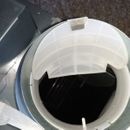Panasonic Whispergreen with flimsy flap damper
Hi All,
I am having a Panasonic Whispergreen Select bath exhaust fan installed next week. One thing that really surprised me is the flimsy plastic flapper with a foam notch (see the attached pic) for a damper, that seems to present the below issues:
1. Air leakage to the outside when the fan isn’t in use. With so much emphasis on sealing the attic, I am wondering how this would be acceptable in a bathroom exhaust fan.
2. Backdraft from outside when the fan isn’t in use.
I am wondering what Green people do. Should I have a backdraft damper installed in series?
Thanks in advance.
GBA Detail Library
A collection of one thousand construction details organized by climate and house part










Replies
Venkat,
Coupled with an external termination that has a good damper you shouldn't have a problem. However if you have access to the ducts you can certainly add an in-line damper of much higher quality.
I don't like the way bathroom exhaust fans are usually installed. The connection to the ducts and the damper are outside the box, in most cases making them inaccessible, meaning they are difficult to service or replace - and the box is hard to air-seal. What I've started doing is making an air-sealed plywood box big enough to hold any bathroom exhaust fan, which has the duct and electrical service inside it. It gets covered by a larger vent grill usually used for return-air ducts. This makes servicing or changing out the fan very easy.
Thanks, Malcolm. That's very neat.
Malcolm, that's an elegant solution to a vexing problem. Nice work.
+1 on that. Consider it stolen.
Michael and Peter,
The key is buying the vent cover first, and then adapting the box size to it. This one was a reno where I had access from above, so I caulked the box flange to the ceiling drywall, and lined the outside with foam. For new construction I've used a gasket on the flange.
I think on the next one I'm going to mount an outlet inside the box, and a plug on the fan.
That would make changing it out a five minute job.
Here is a picture of the vent end to end. The rubber coupling sits in the box.
I use these inline with the duct and pulled out the flapper at the fan.
https://www.amazon.com/ALDES-Spring-Loaded-Backdraft-Damper/dp/B002FWR40K
The only issue I have had is that certain high wind conditions can actually still suck the damper open and it is kind of loud when it slams shut. This only happens in the context of a storm with 25mph+ gusts. I am exhausting out the soffit with one of the vents linked below. There may be some dynamics with the vent location.
https://hvacquick.com/products/residential/attic-fans/Soffit-Vents/Primex-SV-Series-Low-Profile-Soffit-Vents
I like the fan box setup!
Matt,
I've got to change out the termination of one of my bathroom fans in a soffit. How have you found the ones you linked to?
I think the Primex are a reasonable option and probably the best that I have seen available for this application. The primary concern with exhausting near a soffit is very moist air going up into the soffits as you know. The primex damper only opens to about 45deg with a 80cfm wisperquite fan so I think the moist stream of air is directed well away from the soffit. My roof was converted from vented (well it was vented and conditioned, but that is a longer story) to spray foam/conditioned. I updated the bath fans and exterior vents in preparation for spray foam. I replaced the the vented vinyl soffit about 12" to either side of the exhaust with solid PVC.
When I got the house there were vents (this style https://www.homedepot.com/p/Deflect-o-4-in-x-4-in-Plastic-Under-Eave-Vent-EVE-6/100133010) in the soffits and 4" flex running towards them, but the flex was not actually connected to the vents. There were no notable mold issues, but no idea of the prior owners showering/exhaust use habits.
Panasonic makes a soffit exhaust, but it is limited to 4" and I wanted to run as large of ducts as possible and the Primex was available in 5". 5" was the compromise vs 6" and the position of the exhaust in the soffit. The goal was to position the exhaust as far out as possible. The final elbow went over the top of the band joist instead of through it, which limited the ability to go to 6" exhaust.
Edit...When it is windy I see the Primex damper open frequently. I tried removing it to see if it changed the high wind dynamics with the inline damper and it did not. It is effective at preventing wasps/bees form making a home so I replaced it.
Matt,
Thanks. I can get it right out almost to the eaves. That should work well.